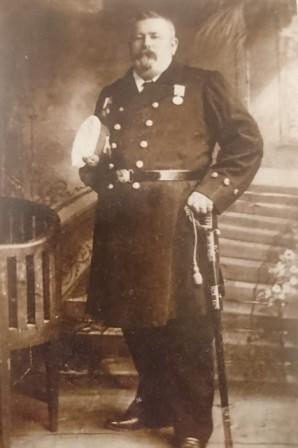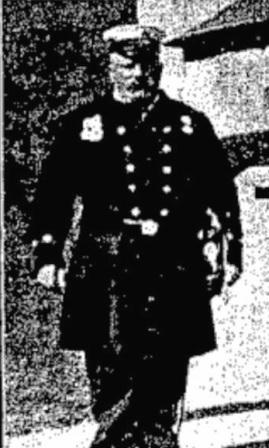I would like to thank John Considine for sending this article and the photographs Cork Examiner, May 8th, 1913.Popular Coastguard OfficerRETIRES FROM SERVICEINTERESTING RECORDIn a notice which appeared in the “Examiner” in connection with the Snowdon Range’s almost unprecedented plight and her almost miraculous escape from it, particulars regarding Mr. Buckley’s exploits in daring rescue work were given. In the efforts that were made to save the crew of the ill-fated Leon XIII he played a heroic part. This French vessel was driven into Quilty, County of Clare, by a violent storm and was jammed in closely between two rocks. When signals of distress were eventually seen, and when calls for aid were eventually heard, rescue work was swiftly and surely undertaken. The brave Quilty men with their canoes and a British cruiser with her lifeboats, cleaved their way to the Leon XIII. Mr. Buckley, always ready to respond to calls of this character, had charge of the Coastguard station at Seafield when the summons for aid came. Without calculating the risks that were to be faced, he with his crew set off in the lifeboat from Liscannor, a distance of twenty miles. The lifeboat broke down, but she was quickly righted, and the intrepid coastguard officer and his crew in the teeth of a fierce storm bore down on the Bay of Quilty. When they got within about half a mile of the wreck they could hear the agonising screams of the Frenchmen. Eventually they got under the bow of the Leon XIII, and though the sea was mountain high they succeeded in rescuing a French seaman who was buffeted about by the waves and was almost on the point of death. The scene presented as his crew jumped from the rigging into the breast of the angry waters, from which providentially they were rescued by brave men, was calculated to draw enduring lines on the minds of those who beheld it. For his action on that occasion Mr. Buckley was presented with a medal and a certificate in vellum by the French Government. The following particulars of another thrilling story of the sea, in which the subject of this notice figures conspicuously, may be of interest: - on the 11th November 1891 during a terrific storm, a ship named the Benvenue was sunk down to her lower yards abreast of Seabrook lifeboat house. In their terrible predicament the crew climbed to the rigging, and the heavy seas lashed around them with unrelenting fury, their cries for aid being indeed piteous. Five seamen, seeing no hope of rescue, jumped into the water and were almost instantly drowned. Immediately the lifeboat put out from Seabrook, with Mr. Buckley amongst the crew, but the seas were so rough that the boat was capsized at an early stage of her adventure. The oars were smashed and owing to their having come in contact with a heavy steel spar, some of the men had their legs broken. The boat was eventually righted, but she was quickly washed ashore by the terrific sea. The next time the lifeboat was taken two miles to westward, to Hythe, and at this place there was a handoff rope about 250 fathoms in length, belonging to the Lifeboat Institution, brought into requisition. An idea of the perils which the lifeboat’s crew faced and of the hardships they had to endure may be gathered from the fact that the boat was capsized eight times in succession. Nothing daunted, however, Mr. Buckley and his comrades hauled away to a well-known floating mark, from which they made sail to bear down on the wreck. Whilst going to her, however, the boat capsized, and all its occupants were washed overboard. A man named Fagg unfortunately lost his life. Mr. Buckley tried to lash him to the mast of the boat, which was floating, as he could not swim, but a heavy sea put them asunder, and the subject of this sketch never saw his comrade again. He himself was picked up about two miles from where the boat capsized, and he woke up next morning in the residence of a gentleman in the neighbourhood. The significant feature associated with this wreck was that though the lifeboat’s crew went forth so gallantly to the rescue of the crew of the Benvenue, they themselves had to be taken from the water by the inhabitants of the district bordering on the place where the wreck occurred.
The following is a terse record of Mr. Buckley’s experience in the service: - A number of his friends in Crosshaven testified their appreciation of Mr. Buckley’s many fine qualities by making him a presentation on the occasion of his retirement. It is gratifying to note that he will continue to reside at this pretty seaside resort, and his well-wishers - and they belong to all classes in Crosshaven – dearly hope that he will be spared for many years to enjoy deserved rest. It is no exaggeration to say that his conduct in the discharge of the duties imposed on him he reflected credit on the service to which he belonged, as well as on the reputation of his countrymen for courage in the face of danger. | |||||||||

